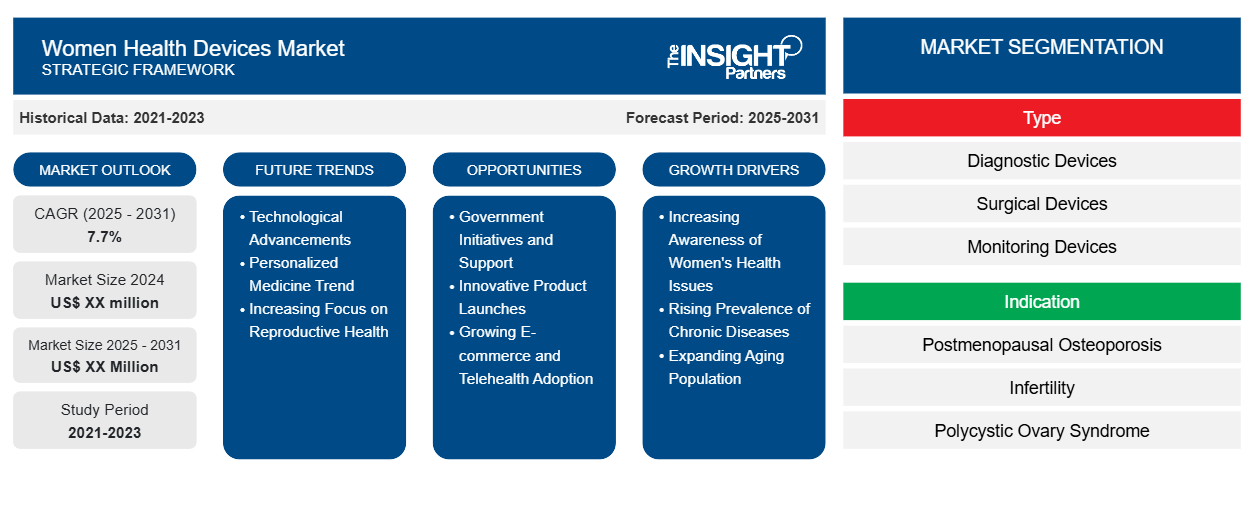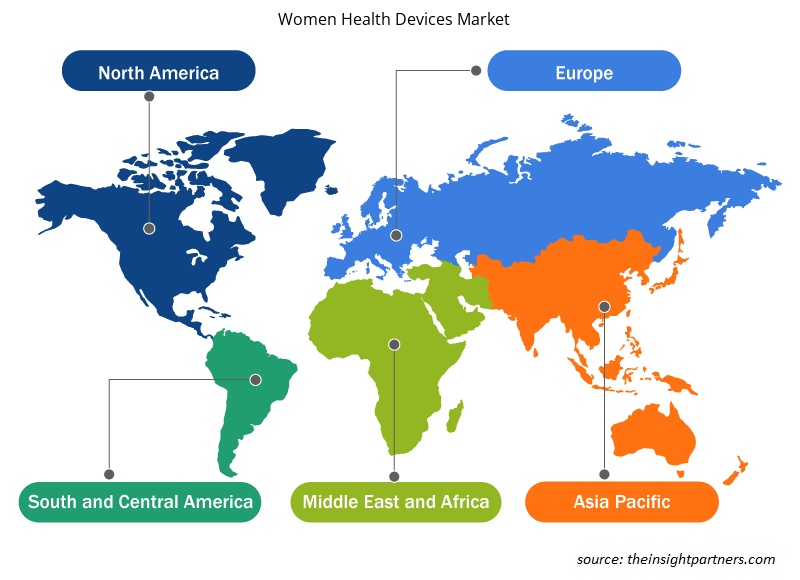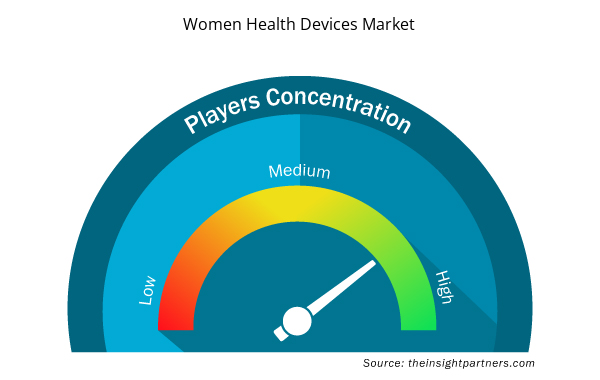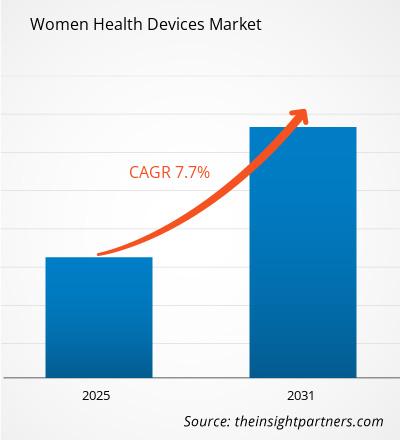Si prevede che il mercato dei dispositivi per la salute femminile registrerà un CAGR del 7,7% dal 2025 al 2031, con una dimensione di mercato in espansione da XX milioni di dollari nel 2024 a XX milioni di dollari entro il 2031.
Il report è segmentato per tipo (dispositivi diagnostici, dispositivi chirurgici, dispositivi di monitoraggio); per indicazione (osteoporosi postmenopausale, infertilità, sindrome dell'ovaio policistico, endometriosi, cancro e altre indicazioni); e utente finale (ospedali e cliniche, centri ginecologici, istituti di ricerca e altri utenti finali). L'analisi globale è ulteriormente suddivisa a livello regionale e nei principali paesi. Il report offre il valore in USD per l'analisi e i segmenti di cui sopra.
Scopo del rapporto
Il report Women Health Devices Market di The Insight Partners mira a descrivere il panorama attuale e la crescita futura, i principali fattori trainanti, le sfide e le opportunità. Ciò fornirà spunti a vari stakeholder aziendali, come:
- Fornitori/produttori di tecnologia: per comprendere le dinamiche di mercato in evoluzione e conoscere le potenziali opportunità di crescita, consentendo loro di prendere decisioni strategiche informate.
- Investitori: condurre un'analisi completa delle tendenze relative al tasso di crescita del mercato, alle proiezioni finanziarie del mercato e alle opportunità esistenti lungo la catena del valore.
- Enti di regolamentazione: regolamentano le politiche e le attività di controllo sul mercato allo scopo di ridurre al minimo gli abusi, preservare la fiducia degli investitori e sostenere l'integrità e la stabilità del mercato.
Segmentazione del mercato dei dispositivi per la salute delle donne
Tipo
- Dispositivi diagnostici
- Dispositivi chirurgici
- Dispositivi di monitoraggio
Indicazione
- Osteoporosi postmenopausale
- Infertilità
- Sindrome dell'ovaio policistico
- Endometriosi
- Cancro e altre indicazioni
Utente finale
- Ospedali e cliniche
- Centri di ginecologia
- Istituti di ricerca e altri utenti finali
Geografia
- America del Nord
- Europa
- Asia-Pacifico
- America del Sud e Centro
- Medio Oriente e Africa
Personalizza questo report in base alle tue esigenze
Riceverai la personalizzazione gratuita di qualsiasi report, comprese parti di questo report, o analisi a livello nazionale, pacchetto dati Excel, oltre a usufruire di grandi offerte e sconti per start-up e università
Mercato dei dispositivi per la salute delle donne: approfondimenti strategici

- Scopri le principali tendenze di mercato in questo rapporto.Questo campione GRATUITO includerà analisi di dati che spaziano dalle tendenze di mercato alle stime e alle previsioni.
Fattori trainanti della crescita del mercato dei dispositivi per la salute delle donne
- Maggiore consapevolezza dei problemi di salute delle donne: c'è una crescente consapevolezza tra la vasta popolazione riguardo ai problemi di salute delle donne, tra cui la salute riproduttiva, la menopausa e le condizioni croniche. Questa maggiore consapevolezza spinge la domanda di dispositivi sanitari specializzati per garantire la gestione e il trattamento efficaci delle malattie della salute delle donne
- Aumento della prevalenza di malattie croniche: la crescente incidenza e prevalenza di condizioni come il cancro al seno, la sindrome dell'ovaio policistico (PCOS) e l'endometriosi sta aumentando la domanda di dispositivi diagnostici e terapeutici personalizzati per la salute delle donne. Inoltre, anche le differenze ormonali e i fattori legati allo stile di vita contribuiscono alla vulnerabilità delle donne a queste malattie.
- Invecchiamento della popolazione in espansione: con l'invecchiamento della popolazione globale, aumenta la necessità di dispositivi sanitari per affrontare i problemi prevalenti nelle donne anziane, come l'osteoporosi e le malattie cardiovascolari. Con l'invecchiamento della popolazione, c'è una fascia demografica più ampia di donne che soffrono di malattie croniche legate all'età, aumentando la domanda di soluzioni sanitarie.
Tendenze future del mercato dei dispositivi per la salute delle donne
- Progressi tecnologici: le innovazioni nella tecnologia medica, come i dispositivi indossabili, i dispositivi di monitoraggio remoto e le soluzioni di telemedicina, stanno rendendo più facile per le donne gestire efficacemente la propria salute. Questi progressi migliorano anche i risultati per i pazienti e potenziano il coinvolgimento degli utenti. I progressi nella tecnologia indossabile hanno portato allo sviluppo di dispositivi che monitorano vari parametri sanitari, come la frequenza cardiaca, l'attività fisica e i livelli di glucosio. Questi dispositivi sono particolarmente utili per le donne che gestiscono malattie croniche.
- Tendenza della medicina personalizzata: l'ascesa della medicina personalizzata, che progetta il trattamento in base alle caratteristiche individuali, sta influenzando lo sviluppo di dispositivi che forniscono monitoraggio della salute personalizzato e opzioni di trattamento per le donne. Inoltre, le applicazioni progettate specificamente per le donne possono tracciare i sintomi, gestire i farmaci e fornire consigli sulla salute personalizzati, migliorando così la gestione delle malattie croniche.
- Maggiore attenzione alla salute riproduttiva: la crescente consapevolezza sulla salute riproduttiva ha portato a un aumento dei dispositivi che aiutano nel monitoraggio della fertilità, nella previsione dell'ovulazione e nella gestione generale della salute riproduttiva. Inoltre, si prevede che le innovazioni orientate al monitoraggio della salute della gravidanza, come i monitor fetali e i dispositivi connessi, acquisiranno popolarità nei prossimi anni
Opportunità di mercato per i dispositivi sanitari femminili
- Iniziative e supporto governativi: molti governi stanno implementando iniziative incentrate sul miglioramento della salute delle donne, tra cui finanziamenti per la ricerca e incentivi per le aziende per sviluppare dispositivi sanitari innovativi rivolti alle donne. Inoltre, il crescente riconoscimento dei problemi di salute delle donne ha portato a maggiori investimenti da parte sia del settore privato che di quello pubblico per sviluppare dispositivi e soluzioni sanitarie innovative.
- Lanci di prodotti innovativi: l'introduzione continua di nuovi prodotti, tra cui monitor sanitari indossabili, tracker della fertilità e dispositivi per la gestione del dolore, aumenta la crescita del mercato e soddisfa esigenze diverse. Inoltre, i produttori collaborano sempre di più con operatori sanitari e aziende tecnologiche per migliorare l'offerta di prodotti e raggiungere mercati più ampi.
- Crescente adozione di e-commerce e telemedicina: l'ascesa di servizi di e-commerce e telemedicina ha reso più facile per le donne accedere a dispositivi sanitari e consulenze, ampliando così la portata del mercato. Inoltre, il ruolo dei social media nell'educazione e nell'emancipazione delle donne sui problemi di salute svolge un ruolo fondamentale nel guidare la domanda di dispositivi sanitari per le donne.
Approfondimenti regionali sul mercato dei dispositivi per la salute delle donne
Le tendenze regionali e i fattori che influenzano il mercato dei dispositivi per la salute delle donne durante il periodo di previsione sono stati ampiamente spiegati dagli analisti di Insight Partners. Questa sezione discute anche i segmenti e la geografia del mercato dei dispositivi per la salute delle donne in Nord America, Europa, Asia Pacifico, Medio Oriente e Africa e America meridionale e centrale.

- Ottieni i dati specifici regionali per il mercato dei dispositivi per la salute delle donne
Ambito del rapporto di mercato sui dispositivi per la salute delle donne
| Attributo del report | Dettagli |
|---|---|
| Dimensioni del mercato nel 2024 | XX milioni di dollari USA |
| Dimensioni del mercato entro il 2031 | XX milioni di dollari USA |
| CAGR globale (2025 - 2031) | 7,7% |
| Dati storici | 2021-2023 |
| Periodo di previsione | 2025-2031 |
| Segmenti coperti | Per tipo
|
| Regioni e Paesi coperti | America del Nord
|
| Leader di mercato e profili aziendali chiave |
|
Densità dei player del mercato dei dispositivi per la salute delle donne: comprendere il suo impatto sulle dinamiche aziendali
Il mercato dei dispositivi per la salute delle donne sta crescendo rapidamente, spinto dalla crescente domanda degli utenti finali dovuta a fattori quali l'evoluzione delle preferenze dei consumatori, i progressi tecnologici e una maggiore consapevolezza dei benefici del prodotto. Con l'aumento della domanda, le aziende stanno ampliando le loro offerte, innovando per soddisfare le esigenze dei consumatori e capitalizzando sulle tendenze emergenti, il che alimenta ulteriormente la crescita del mercato.
La densità degli operatori di mercato si riferisce alla distribuzione di aziende o società che operano in un particolare mercato o settore. Indica quanti concorrenti (operatori di mercato) sono presenti in un dato spazio di mercato in relazione alle sue dimensioni o al valore di mercato totale.
Le principali aziende che operano nel mercato dei dispositivi per la salute delle donne sono:
- ALLERGANO
- Azienda
- Società CooperSurgical Inc.
- Cadence Inc.
- Siemens Healthcare Società a Responsabilità Limitata
Disclaimer : le aziende elencate sopra non sono classificate secondo un ordine particolare.

- Ottieni una panoramica dei principali attori del mercato dei dispositivi per la salute delle donne
Punti chiave di vendita
- Copertura completa: il rapporto copre in modo completo l'analisi di prodotti, servizi, tipologie e utenti finali del mercato dei dispositivi per la salute delle donne, fornendo una panoramica olistica.
- Analisi degli esperti: il rapporto è compilato sulla base della conoscenza approfondita di esperti e analisti del settore.
- Informazioni aggiornate: il rapporto garantisce la pertinenza aziendale grazie alla copertura di informazioni recenti e tendenze nei dati.
- Opzioni di personalizzazione: questo report può essere personalizzato per soddisfare le esigenze specifiche del cliente e adattarsi in modo appropriato alle strategie aziendali.
Il rapporto di ricerca sul mercato dei dispositivi per la salute delle donne può, quindi, aiutare a guidare il percorso di decodificazione e comprensione dello scenario del settore e delle prospettive di crescita. Sebbene possano esserci alcune preoccupazioni valide, i vantaggi complessivi di questo rapporto tendono a superare gli svantaggi.
- Analisi storica (2 anni), anno base, previsione (7 anni) con CAGR
- Analisi PEST e SWOT
- Valore/volume delle dimensioni del mercato - Globale, regionale, nazionale
- Industria e panorama competitivo
- Set di dati Excel



Report Coverage
Revenue forecast, Company Analysis, Industry landscape, Growth factors, and Trends

Segment Covered
This text is related
to segments covered.

Regional Scope
North America, Europe, Asia Pacific, Middle East & Africa, South & Central America

Country Scope
This text is related
to country scope.
Domande frequenti
Coloplast Corp,Hologic Inc., Cooper Medical, Inc. (CooperSurgical Inc.), Cadence Inc., Siemens Healthineers, Koninklijke Philips N.V., GE Healthcare, Carestream Health, Atlantic Medical Group (Atlantic OB-GYN), Valley Health System, Inc. are are some of the major market players operating in the market
The Diagnostic Devices segment accounts for highest revenue in type sgement in 2023
North America region dominated the women health devices market in 2023
Asia Pacific region dominated the women health devices market in 2023
The Women Health Devices Market is estimated to witness a CAGR of 7.7% from 2023 to 2031
The major factors driving the women health devices market are:
1.Increasing awareness of women Health Issues
2. Rising prevelance of chronic disorders
3. Expanding aging population
Trends and growth analysis reports related to Life Sciences : READ MORE..
The List of Companies
1. ALLERGAN
2. Hologic Inc.
3. CooperSurgical Inc.
4. Cadence Inc.
5. Siemens Healthcare Private Limited
6. Koninklijke Philips N.V.
7. General Electric Company
8. Carestream Health
9. Atlantic OB-GYN
10. Valley Health System, Inc.
The Insight Partners performs research in 4 major stages: Data Collection & Secondary Research, Primary Research, Data Analysis and Data Triangulation & Final Review.
- Data Collection and Secondary Research:
As a market research and consulting firm operating from a decade, we have published and advised several client across the globe. First step for any study will start with an assessment of currently available data and insights from existing reports. Further, historical and current market information is collected from Investor Presentations, Annual Reports, SEC Filings, etc., and other information related to company’s performance and market positioning are gathered from Paid Databases (Factiva, Hoovers, and Reuters) and various other publications available in public domain.
Several associations trade associates, technical forums, institutes, societies and organization are accessed to gain technical as well as market related insights through their publications such as research papers, blogs and press releases related to the studies are referred to get cues about the market. Further, white papers, journals, magazines, and other news articles published in last 3 years are scrutinized and analyzed to understand the current market trends.
- Primary Research:
The primarily interview analysis comprise of data obtained from industry participants interview and answers to survey questions gathered by in-house primary team.
For primary research, interviews are conducted with industry experts/CEOs/Marketing Managers/VPs/Subject Matter Experts from both demand and supply side to get a 360-degree view of the market. The primary team conducts several interviews based on the complexity of the markets to understand the various market trends and dynamics which makes research more credible and precise.
A typical research interview fulfils the following functions:
- Provides first-hand information on the market size, market trends, growth trends, competitive landscape, and outlook
- Validates and strengthens in-house secondary research findings
- Develops the analysis team’s expertise and market understanding
Primary research involves email interactions and telephone interviews for each market, category, segment, and sub-segment across geographies. The participants who typically take part in such a process include, but are not limited to:
- Industry participants: VPs, business development managers, market intelligence managers and national sales managers
- Outside experts: Valuation experts, research analysts and key opinion leaders specializing in the electronics and semiconductor industry.
Below is the breakup of our primary respondents by company, designation, and region:

Once we receive the confirmation from primary research sources or primary respondents, we finalize the base year market estimation and forecast the data as per the macroeconomic and microeconomic factors assessed during data collection.
- Data Analysis:
Once data is validated through both secondary as well as primary respondents, we finalize the market estimations by hypothesis formulation and factor analysis at regional and country level.
- Macro-Economic Factor Analysis:
We analyse macroeconomic indicators such the gross domestic product (GDP), increase in the demand for goods and services across industries, technological advancement, regional economic growth, governmental policies, the influence of COVID-19, PEST analysis, and other aspects. This analysis aids in setting benchmarks for various nations/regions and approximating market splits. Additionally, the general trend of the aforementioned components aid in determining the market's development possibilities.
- Country Level Data:
Various factors that are especially aligned to the country are taken into account to determine the market size for a certain area and country, including the presence of vendors, such as headquarters and offices, the country's GDP, demand patterns, and industry growth. To comprehend the market dynamics for the nation, a number of growth variables, inhibitors, application areas, and current market trends are researched. The aforementioned elements aid in determining the country's overall market's growth potential.
- Company Profile:
The “Table of Contents” is formulated by listing and analyzing more than 25 - 30 companies operating in the market ecosystem across geographies. However, we profile only 10 companies as a standard practice in our syndicate reports. These 10 companies comprise leading, emerging, and regional players. Nonetheless, our analysis is not restricted to the 10 listed companies, we also analyze other companies present in the market to develop a holistic view and understand the prevailing trends. The “Company Profiles” section in the report covers key facts, business description, products & services, financial information, SWOT analysis, and key developments. The financial information presented is extracted from the annual reports and official documents of the publicly listed companies. Upon collecting the information for the sections of respective companies, we verify them via various primary sources and then compile the data in respective company profiles. The company level information helps us in deriving the base number as well as in forecasting the market size.
- Developing Base Number:
Aggregation of sales statistics (2020-2022) and macro-economic factor, and other secondary and primary research insights are utilized to arrive at base number and related market shares for 2022. The data gaps are identified in this step and relevant market data is analyzed, collected from paid primary interviews or databases. On finalizing the base year market size, forecasts are developed on the basis of macro-economic, industry and market growth factors and company level analysis.
- Data Triangulation and Final Review:
The market findings and base year market size calculations are validated from supply as well as demand side. Demand side validations are based on macro-economic factor analysis and benchmarks for respective regions and countries. In case of supply side validations, revenues of major companies are estimated (in case not available) based on industry benchmark, approximate number of employees, product portfolio, and primary interviews revenues are gathered. Further revenue from target product/service segment is assessed to avoid overshooting of market statistics. In case of heavy deviations between supply and demand side values, all thes steps are repeated to achieve synchronization.
We follow an iterative model, wherein we share our research findings with Subject Matter Experts (SME’s) and Key Opinion Leaders (KOLs) until consensus view of the market is not formulated – this model negates any drastic deviation in the opinions of experts. Only validated and universally acceptable research findings are quoted in our reports.
We have important check points that we use to validate our research findings – which we call – data triangulation, where we validate the information, we generate from secondary sources with primary interviews and then we re-validate with our internal data bases and Subject matter experts. This comprehensive model enables us to deliver high quality, reliable data in shortest possible time.

 Ottieni un campione gratuito per questo repot
Ottieni un campione gratuito per questo repot